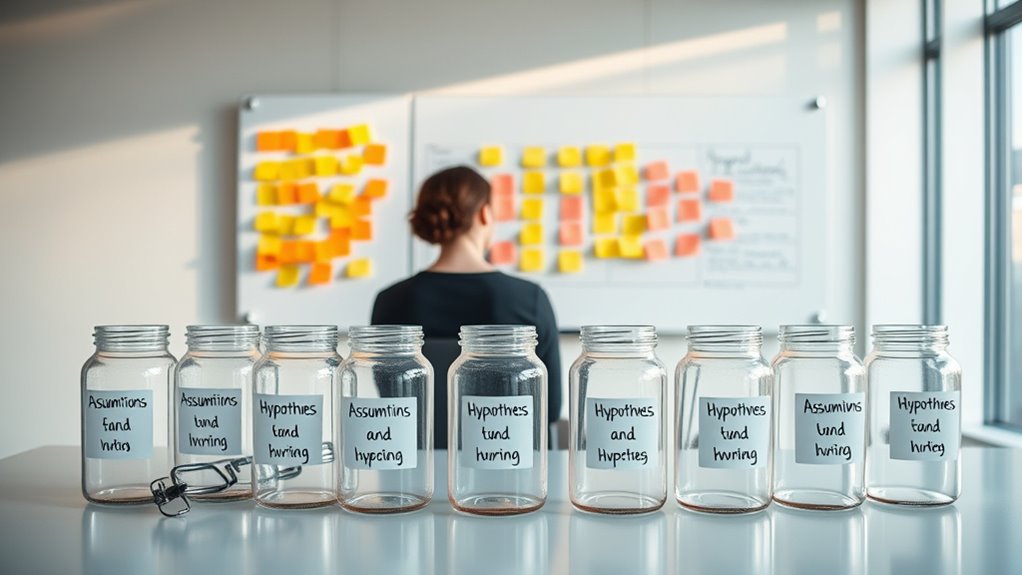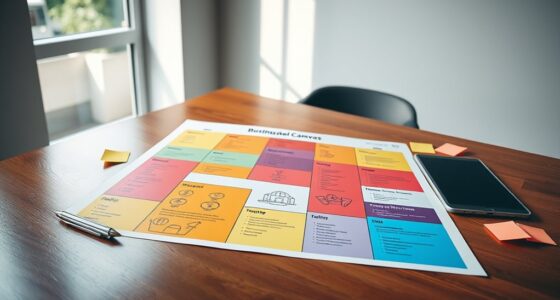To de-risk innovation, you should surface, test, and validate your core assumptions about customer needs, preferences, and market behaviors. Use techniques like scenario analysis, pre-mortems, and diverse brainstorming to identify hidden biases and risks early on. Structuring your assumption validation with targeted experiments and continuous feedback helps refine your approach. Embedding this toolkit into your workflow and fostering a culture of experimentation guarantees smarter, more confident decisions—if you keep exploring, you’ll discover how to master this process.
Key Takeaways
- Map and prioritize critical assumptions related to market, customer needs, and regulations to identify potential risks early.
- Use diverse brainstorming, scenario analysis, and pre-mortem techniques to uncover hidden biases and vulnerabilities.
- Design targeted experiments like customer interviews and pilot programs to validate assumptions and gather actionable insights.
- Embed assumption testing into the innovation process with regular reviews, continuous feedback, and risk mitigation strategies.
- Foster a culture of learning and experimentation, encouraging open communication about failures to refine and de-risk innovation efforts.
Understanding the Core Assumptions Behind Innovation

To truly understand innovation, you need to identify the core assumptions driving it. These assumptions shape your approach to customer feedback and market segmentation. Ask yourself what you believe about your customers’ needs, preferences, and behaviors. Are you assuming that a specific segment will respond positively to your idea? Or that customer feedback will validate your product’s value? Recognizing these underlying beliefs helps you determine if your assumptions are valid or need testing. By surfacing these core ideas, you can challenge or confirm them early, reducing risks. This clarity enables you to refine your approach, better align with your target market, and avoid costly missteps. Additionally, understanding the role of antique elements in creating a distinctive environment can inform your innovation strategies. Ultimately, understanding your foundational assumptions is key to making informed, confident innovation decisions.
Techniques for Identifying Hidden Biases and Risks

Identifying hidden biases and risks requires more than just surface-level analysis of your assumptions. To uncover unseen issues, you can use bias detection techniques like diverse brainstorming sessions, structured checklists, and scenario analysis. These methods help reveal implicit biases that might influence your decision-making unknowingly. Risk mitigation involves systematically examining your assumptions for potential pitfalls and blind spots. Techniques such as pre-mortem analysis or red teaming challenge your ideas from different perspectives, exposing vulnerabilities early. Incorporating legal considerations into your process ensures compliance and reduces the likelihood of overlooked risks. By actively seeking out biases and risks, you prevent them from escalating later in your project. Incorporating these techniques into your process fosters a more robust understanding of potential pitfalls, ultimately reducing uncertainty and increasing your chances of successful innovation.
Structuring Assumption Testing and Validation Processes

Establishing a clear and systematic approach to assumption testing and validation is essential for reducing uncertainty in your innovation process. Begin by mapping out critical assumptions related to market dynamics and regulatory hurdles. Design tests that directly challenge these assumptions, such as customer interviews, pilot programs, or expert reviews. Prioritize assumptions based on their impact and uncertainty to focus your efforts efficiently. Incorporate feedback loops to refine your understanding continuously. Regularly review progress against predefined milestones to identify gaps early. This structured process helps you adapt quickly to changing market conditions and regulatory environments, minimizing risks. By systematically validating assumptions, you create a more resilient innovation pathway and reduce the likelihood of costly failures stemming from overlooked market or regulatory challenges. Integrating natural elements and creating a calming environment can further support your team’s focus during the validation process.
Integrating the Toolkit Into the Innovation Workflow

Integrating the toolkit seamlessly into your innovation workflow guarantees that assumption testing and validation become an essential part of daily operations rather than standalone steps. Start by embedding assumption mapping into your project planning to identify critical uncertainties early. Use risk prioritization to focus resources on assumptions that pose the highest threat to your project’s success. Incorporate regular assumption reviews into your development cycle, ensuring validation activities are continuous rather than isolated events. This approach helps you maintain a clear view of what’s uncertain and what needs testing, reducing blind spots. Additionally, understanding the importance of projector technology can inform your decision-making process, ensuring your innovations are grounded in realistic technological capabilities. By making assumption mapping and risk prioritization routine, you create a proactive environment where risks are addressed upfront, accelerating decision-making and increasing the likelihood of successful innovation.
Building a Culture of Informed Experimentation and Learning

Creating a culture of informed experimentation and learning requires fostering an environment where teams feel empowered to test assumptions, learn from failures, and adapt quickly. You should prioritize gathering customer feedback early and often, ensuring insights shape your experiments. This approach helps allocate resources effectively, focusing on ideas with the highest potential impact. Encourage open communication about failures as opportunities for growth, rather than setbacks. When teams see that experimentation is valued, they become more willing to take calculated risks. By continuously learning and adjusting based on real-world data, your organization reduces uncertainty and builds resilience. Cultivating this mindset transforms innovation into a strategic process, making it easier to develop successful solutions while minimizing resource waste. Incorporating mindful decluttering strategies can also help teams maintain clarity and focus during the innovation process.
Frequently Asked Questions
How Does the Assumption Surfacing Toolkit Adapt to Different Industry Contexts?
When exploring how the assumption surfacing toolkit adapts to different industry contexts, you should focus on industry-specific adaptations and organizational culture. You’ll find that customizing questions and techniques helps uncover unique assumptions in each sector. By understanding your organization’s culture, you can tailor approaches that resonate, making assumption testing more effective. This flexibility guarantees the toolkit stays pertinent and impactful, regardless of the industry you operate in.
What Are Common Challenges Faced When Implementing the Toolkit Organization-Wide?
When implementing the toolkit organization-wide, you often face challenges like change management resistance and stakeholder engagement. People may be hesitant to shift their mindset or question long-standing assumptions. To succeed, you need clear communication, ongoing support, and active involvement from stakeholders. Addressing resistance early and fostering a culture of openness helps guarantee smooth adoption, making it easier to identify and test assumptions at all levels.
How Can Small Teams Effectively Utilize the Toolkit With Limited Resources?
Imagine your small team as a ship steering stormy seas—you can’t afford to waste supplies. To make the most of limited resources, focus on resource prioritization, identifying key assumptions that could sink your project. Foster team collaboration by sharing insights and brainstorming solutions together, turning challenges into opportunities. By streamlining efforts and working cohesively, you’ll steer your innovation journey confidently, even with a lean crew and tight resources.
What Metrics Best Measure the Success of Assumption Validation Efforts?
When measuring the success of assumption validation efforts, focus on qualitative feedback from customers and overall customer satisfaction. These metrics reveal whether your assumptions align with user needs and expectations. You can also track changes in customer sentiment, engagement levels, and repeat usage. By consistently gathering and analyzing this feedback, you guarantee your validation efforts genuinely improve the product, reducing risks and increasing the likelihood of market success.
How Does the Toolkit Support Managing Rapid Innovation Cycles?
They say “a stitch in time saves nine,” and that’s true for managing rapid innovation cycles. The toolkit helps you iterate quickly by supporting iterative testing and risk mitigation. It encourages you to surface assumptions early, test them fast, and adapt swiftly. This proactive approach minimizes risks, accelerates learning, and keeps your innovation on track, ensuring you can respond to changes without losing momentum.
Conclusion
Now that you have the tools to surface and challenge assumptions, the next step is vital. Will you uncover the hidden biases that threaten your innovation’s success? Or will untested beliefs hold you back? Embrace the assumption surfacing toolkit fully, and you’ll open a new level of confidence and agility. The real question is—are you ready to turn uncertainty into your greatest advantage? The journey of informed innovation starts now—are you in?









